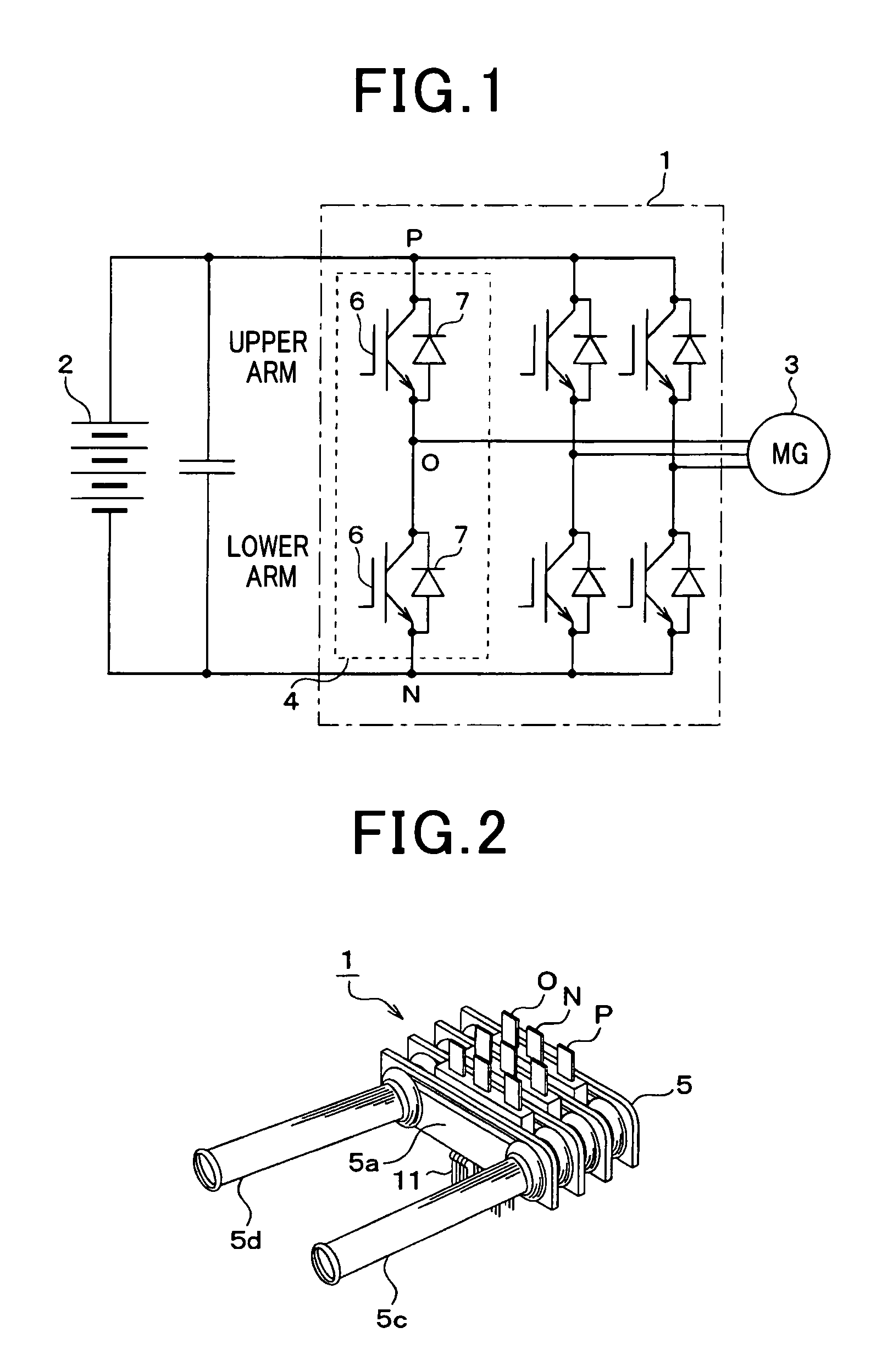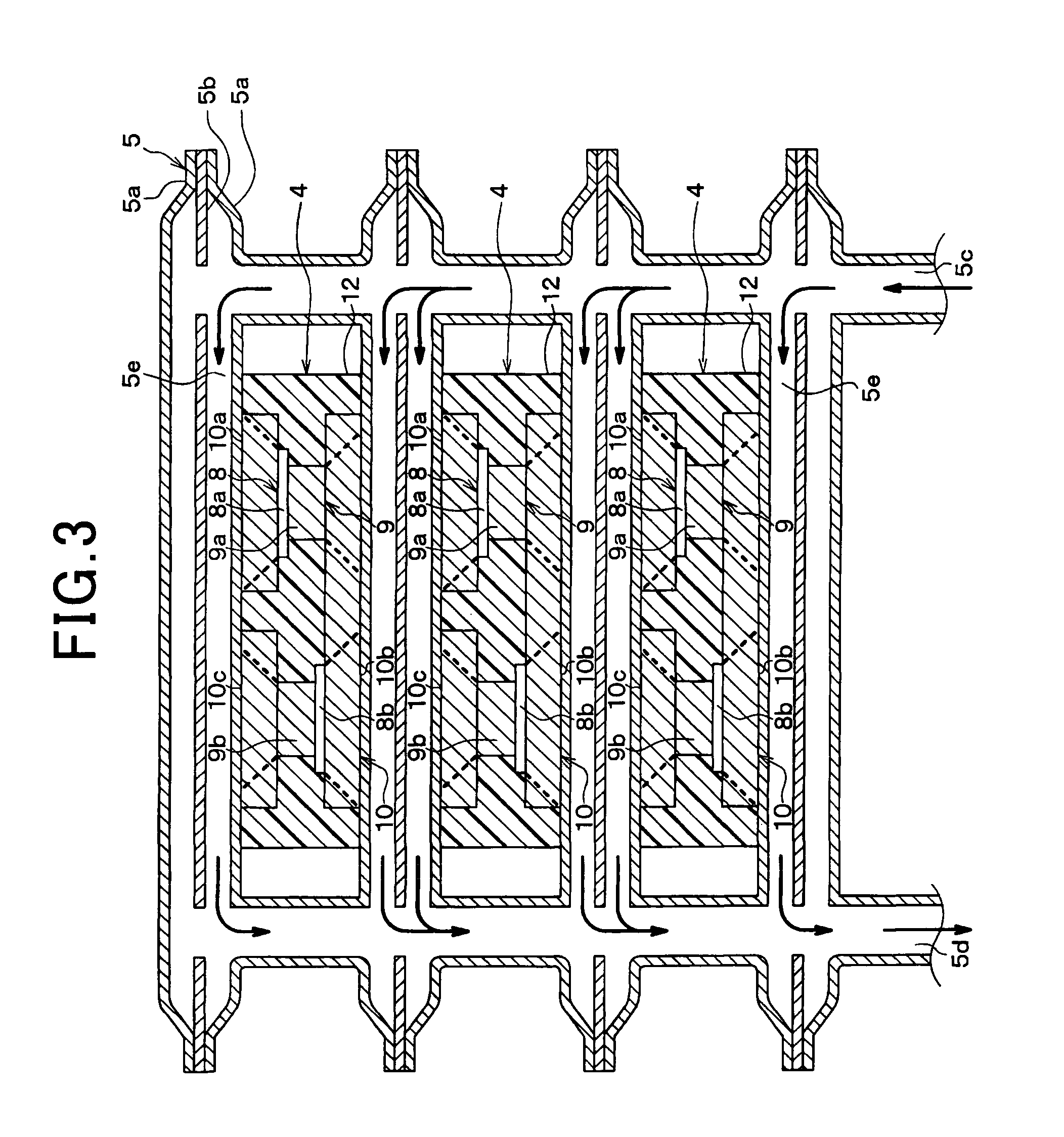Semiconductor device accommodating semiconductor module with heat radiation structure
a technology of semiconductor modules and semiconductor devices, applied in semiconductor devices, lighting and heating apparatus, cooling/ventilation/heating modifications, etc., can solve problems such as restricted thermal design, and achieve the effect of effective cooling
- Summary
- Abstract
- Description
- Claims
- Application Information
AI Technical Summary
Benefits of technology
Problems solved by technology
Method used
Image
Examples
first embodiment
[0034]A first embodiment of the present invention will be described. According to the first embodiment, a semiconductor device including a semiconductor module according to an embodiment of the present invention will be described, giving as an example an inverter having a cooling mechanism.
[0035]FIG. 1 is a circuit diagram of an inverter 1. FIG. 2 is a perspective view of the inverter 1. FIG. 3 is a cross-sectional view of the inverter 1. FIG. 3 is equivalent to a cross-section of the inverter 1 taken on a plane perpendicular to the up / down direction of the surface of the paper on which FIG. 2 is printed.
[0036]As shown in FIG. 1, the inverter 1 is used to drive, with an alternating current, a three-phase motor 3 that is a load, based on a direct-current power supply 2. The inverter 1 is configured such that serially connected upper arms and lower arms are connected in parallel in three phases. An intermediate potential of the upper arm and the lower arm is applied while being sequen...
second embodiment
[0064]A second embodiment of the present invention will be described. According to the second embodiment, the structure of the semiconductor module 4 is changed from that according to the first embodiment. Other aspects are similar to those according to the first embodiment and, therefore, only sections that differ will be described.
[0065]FIG. 9 is a cross-sectional view of the semiconductor module 4 according to the second embodiment. As shown in FIG. 9, the semiconductor module 4 according to the second embodiment basically has a similar structure as that according to first embodiment, aside from the sizes of the heat sinks 10a and 10c being changed from those according to the first embodiment. Specifically, the size of the heat sink 10c is greater than the size of the heat sink 10a in the left / right direction of the surface of the paper on which FIG. 9 is printed.
[0066]As a result of a structure such as this, the thermal resistance R2 of the lower arm disposed further downstream ...
third embodiment
[0067]A third embodiment of the present invention will be described. According to the third embodiment, the structure of the semiconductor module 4 is changed from that according to the first embodiment. Other aspects are similar to those according to the first embodiment and, therefore, only sections that differ will be described.
[0068]FIG. 10 is a cross-sectional view of the semiconductor module 4 according to the third embodiment. As shown in FIG. 10, the semiconductor module 4 according to the third embodiment basically has a similar structure as that according to first embodiment, aside from the semiconductor module 4 being assembled in the cooling mechanism 5 such that the lower arm is disposed on the upstream side of the coolant flow in the cooling mechanism 5 and the upper arm is disposed on the downstream side. The width of the heat sink 10a of the upper arm becomes wider compared to that of the heat sink 10b of the lower arm disposed on the upper stream side, in the left / r...
PUM
 Login to View More
Login to View More Abstract
Description
Claims
Application Information
 Login to View More
Login to View More - R&D
- Intellectual Property
- Life Sciences
- Materials
- Tech Scout
- Unparalleled Data Quality
- Higher Quality Content
- 60% Fewer Hallucinations
Browse by: Latest US Patents, China's latest patents, Technical Efficacy Thesaurus, Application Domain, Technology Topic, Popular Technical Reports.
© 2025 PatSnap. All rights reserved.Legal|Privacy policy|Modern Slavery Act Transparency Statement|Sitemap|About US| Contact US: help@patsnap.com



